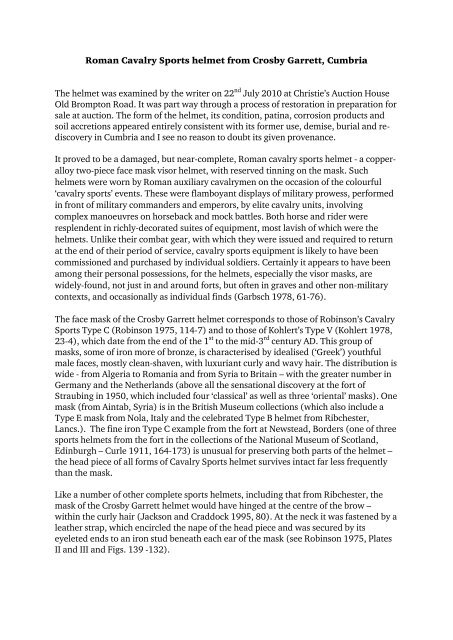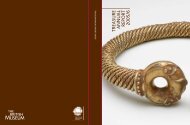Roman Cavalry Sports helmet from Crosby Garrett, Cumbria The ...
Roman Cavalry Sports helmet from Crosby Garrett, Cumbria The ...
Roman Cavalry Sports helmet from Crosby Garrett, Cumbria The ...
Create successful ePaper yourself
Turn your PDF publications into a flip-book with our unique Google optimized e-Paper software.
<strong>Roman</strong> <strong>Cavalry</strong> <strong>Sports</strong> <strong>helmet</strong> <strong>from</strong> <strong>Crosby</strong> <strong>Garrett</strong>, <strong>Cumbria</strong><br />
<strong>The</strong> <strong>helmet</strong> was examined by the writer on 22 nd July 2010 at Christie‟s Auction House<br />
Old Brompton Road. It was part way through a process of restoration in preparation for<br />
sale at auction. <strong>The</strong> form of the <strong>helmet</strong>, its condition, patina, corrosion products and<br />
soil accretions appeared entirely consistent with its former use, demise, burial and rediscovery<br />
in <strong>Cumbria</strong> and I see no reason to doubt its given provenance.<br />
It proved to be a damaged, but near-complete, <strong>Roman</strong> cavalry sports <strong>helmet</strong> - a copperalloy<br />
two-piece face mask visor <strong>helmet</strong>, with reserved tinning on the mask. Such<br />
<strong>helmet</strong>s were worn by <strong>Roman</strong> auxiliary cavalrymen on the occasion of the colourful<br />
„cavalry sports‟ events. <strong>The</strong>se were flamboyant displays of military prowess, performed<br />
in front of military commanders and emperors, by elite cavalry units, involving<br />
complex manoeuvres on horseback and mock battles. Both horse and rider were<br />
resplendent in richly-decorated suites of equipment, most lavish of which were the<br />
<strong>helmet</strong>s. Unlike their combat gear, with which they were issued and required to return<br />
at the end of their period of service, cavalry sports equipment is likely to have been<br />
commissioned and purchased by individual soldiers. Certainly it appears to have been<br />
among their personal possessions, for the <strong>helmet</strong>s, especially the visor masks, are<br />
widely-found, not just in and around forts, but often in graves and other non-military<br />
contexts, and occasionally as individual finds (Garbsch 1978, 61-76).<br />
<strong>The</strong> face mask of the <strong>Crosby</strong> <strong>Garrett</strong> <strong>helmet</strong> corresponds to those of Robinson‟s <strong>Cavalry</strong><br />
<strong>Sports</strong> Type C (Robinson 1975, 114-7) and to those of Kohlert‟s Type V (Kohlert 1978,<br />
23-4), which date <strong>from</strong> the end of the 1 st to the mid-3 rd century AD. This group of<br />
masks, some of iron more of bronze, is characterised by idealised („Greek‟) youthful<br />
male faces, mostly clean-shaven, with luxuriant curly and wavy hair. <strong>The</strong> distribution is<br />
wide - <strong>from</strong> Algeria to <strong>Roman</strong>ia and <strong>from</strong> Syria to Britain – with the greater number in<br />
Germany and the Netherlands (above all the sensational discovery at the fort of<br />
Straubing in 1950, which included four „classical‟ as well as three „oriental‟ masks). One<br />
mask (<strong>from</strong> Aintab, Syria) is in the British Museum collections (which also include a<br />
Type E mask <strong>from</strong> Nola, Italy and the celebrated Type B <strong>helmet</strong> <strong>from</strong> Ribchester,<br />
Lancs.). <strong>The</strong> fine iron Type C example <strong>from</strong> the fort at Newstead, Borders (one of three<br />
sports <strong>helmet</strong>s <strong>from</strong> the fort in the collections of the National Museum of Scotland,<br />
Edinburgh – Curle 1911, 164-173) is unusual for preserving both parts of the <strong>helmet</strong> –<br />
the head piece of all forms of <strong>Cavalry</strong> <strong>Sports</strong> <strong>helmet</strong> survives intact far less frequently<br />
than the mask.<br />
Like a number of other complete sports <strong>helmet</strong>s, including that <strong>from</strong> Ribchester, the<br />
mask of the <strong>Crosby</strong> <strong>Garrett</strong> <strong>helmet</strong> would have hinged at the centre of the brow –<br />
within the curly hair (Jackson and Craddock 1995, 80). At the neck it was fastened by a<br />
leather strap, which encircled the nape of the head piece and was secured by its<br />
eyeleted ends to an iron stud beneath each ear of the mask (see Robinson 1975, Plates<br />
II and III and Figs. 139 -132).
<strong>The</strong> survival of the head piece of the <strong>Crosby</strong> <strong>Garrett</strong> <strong>helmet</strong>, albeit broken and distorted<br />
(now restored by Christie‟s), is exceptional and even more so on account of its unusual<br />
Phrygian form (the so-called „Phrygian cap‟), which gives the face the appearance of a<br />
beardless Jupiter Dolichenus. Furthermore, an associated bronze figurine in the form of<br />
a winged griffin was clearly originally attached to the top of the <strong>helmet</strong> – the curvature<br />
of the griffin‟s base-plate together with remains of solder on its underside correspond<br />
exactly to the curvature and patch of solder preserved on the crest of the head piece.<br />
<strong>The</strong> griffin was the companion of Nemesis, goddess of fate, both of whom were often<br />
associated with gladiatorial combat. As a symbolic agent of death, its image was<br />
entirely appropriate for the finial of a <strong>helmet</strong> worn by an élite cavalryman of the <strong>Roman</strong><br />
army.<br />
Further examples of winged griffin figurines in military contexts include those <strong>from</strong> the<br />
forts at Strageath, Perthshire (Frere and Wilkes 1989, 149, Fig. 74 no. 50) and<br />
Trawscoed, Dyfed (Davies 1987). More significantly, however, the griffin finial of the<br />
<strong>Crosby</strong> <strong>Garrett</strong> <strong>helmet</strong> references another celebrated find, the Ribchester Helmet, part<br />
of a hoard of military equipment discovered by a clog-maker‟s son at Ribchester in 1796.<br />
<strong>The</strong> local antiquary, Charles Townley was able to secure the Ribchester <strong>helmet</strong> and<br />
most of the hoard (Jackson and Craddock 1995, 75), but one of the items that eluded<br />
him was described to him in a letter by the Rev. T.D Whitaker, who had seen the whole<br />
hoard soon after its discovery (Townley 1815, 11-12). With it, said Whitaker, was “a<br />
sphinx of bronze, which, <strong>from</strong> the remains of solder on the lower side, and also <strong>from</strong> its<br />
curvature, appeared to have been attached to some convex surface, probably to the top<br />
of the <strong>helmet</strong>” (cited in Watkin 1883, 153-4). <strong>The</strong> „sphinx‟, it appears, was subsequently<br />
lost by some children to whom it had been given to play with. Perhaps the object was<br />
truly a sphinx, but, as another hybrid creature, it is conceivable that a griffin was<br />
confused with a sphinx. At all events, although some <strong>Roman</strong> cavalry sports <strong>helmet</strong>s are<br />
surmounted by repoussé eagles, as, for example, that <strong>from</strong> Tell Oum Houran, Syria<br />
(Garbsch 1978, Plate 16, 2-4), I am not aware of any other surviving example that<br />
retains a cast crest figure of the type on the <strong>Crosby</strong> <strong>Garrett</strong> <strong>helmet</strong>.<br />
In summary, the <strong>Crosby</strong> <strong>Garrett</strong> <strong>helmet</strong> is an immensely interesting and outstandingly<br />
important find, the prize possession of an auxiliary cavalryman who served in one of<br />
the crack <strong>Roman</strong> cavalry regiments stationed in the frontier region of northern Britain<br />
at a critical period in the history of the province. Its face mask is both extremely finelywrought<br />
and chillingly striking, but it is as an ensemble that the <strong>helmet</strong> is so<br />
exceptional and, in its specifics, unparalleled. It is a find of the greatest national (and,<br />
indeed, international) significance, both for its intrinsic interest and for the additional<br />
light it can be expected to shed on the manufacture and supply of prestige military<br />
equipment as well as on military dispositions in northern Britain in the decades<br />
preceding, spanning and following the construction of Hadrian‟s Wall. In addition, as<br />
an object of beauty and top-quality craftsmanship and a most powerful iconic symbol of<br />
the might of Rome it has an obvious display potential, and that potential would<br />
undoubtedly best be realised in the context of the region in which it was found.<br />
Dr Ralph Jackson<br />
Senior Curator of <strong>Roman</strong>o-British Collections<br />
British Museum
9 th September 2010<br />
References<br />
Curle, J. 1911, A <strong>Roman</strong> frontier post and its people. <strong>The</strong> fort of Newstead in the parish of<br />
Melrose (J. Maclehose, Glasgow).<br />
Davies, J.L. 1987, „A bronze vehicle mount <strong>from</strong> Trawscoed, Dyfed‟, Britannia 18, 277-<br />
8.<br />
Frere, S.S and Wilkes, J.J. 1989, Strageath. Excavations within the <strong>Roman</strong> fort 1973-86<br />
(Britannia Monograph Series, No. 9, London).<br />
Garbsch, J. 1978, Römische Paraderüstungen (Verlag C.H. Beck, Munich)<br />
Jackson, R.P.J. and Craddock, P.T. 1995, „<strong>The</strong> Ribchester Hoard: a descriptive and<br />
technical study‟ in B. Raftery, V. Megaw and V. Rigby (eds.) Sites and Sights of the Iron<br />
Age (Oxbow Monograph 56, Oxford, 1995), 75 – 102.<br />
Kohlert, M. 1978, „Typologie und Chronologie der Gesichtsmasken‟, in Garbsch 1978,<br />
19-28.<br />
Russell Robinson, H. 1975, <strong>The</strong> Armour of Imperial Rome (Arms and Armour Press,<br />
London)<br />
Townley, C. 1815, „Account of antiquities discovered at Ribchester‟, Vetusta monumenta<br />
quae ad rerum Britannicarum memoriam conservandam societas antiquariorum Londini<br />
sumptu suo edenda curavit IV, 1-12.<br />
Watkin, W.T. 1883, <strong>Roman</strong> Lancashire (Liverpool).





